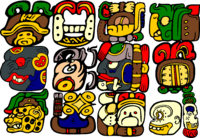Twelve Great Enterprises: Difference between revisions
mNo edit summary |
|||
| (One intermediate revision by the same user not shown) | |||
| Line 21: | Line 21: | ||
The expedition returned home through the "Northern Road", reaching [[Enyama]] after another 5 weeks and then following the coast of Norumbia down to the equator which they reached after another 3 weeks of travels. The success of the operation led to Akutze organising a new , larger, expedition two years afterward. In 1513 he reached Tsurushima again and established the first permanent warehouse. He also sent some of his vessels to explore the region, reaching [[Yajawil of Kahei|Kahei]] and [[Seonko]] among other regions. It was the beginning of what became known as the [[Mutulese Legation]]. | The expedition returned home through the "Northern Road", reaching [[Enyama]] after another 5 weeks and then following the coast of Norumbia down to the equator which they reached after another 3 weeks of travels. The success of the operation led to Akutze organising a new , larger, expedition two years afterward. In 1513 he reached Tsurushima again and established the first permanent warehouse. He also sent some of his vessels to explore the region, reaching [[Yajawil of Kahei|Kahei]] and [[Seonko]] among other regions. It was the beginning of what became known as the [[Mutulese Legation]]. | ||
Akutze would then began organising annual trans-makrian travels between the [[Mutul]], [[Tsurushima]], and [[Enyama]]. He would personally lead two more expedition in 1515 and 1516. He then married the daughter of one of Sakurajima' local clans and settled permanently in [[Yu]] in 1520, leaving the position of Eb'et and the gestion of the Mutulese Legation to his stepbrother [[Chak Ik'atz]]. Unfortunately for the Nich family, the 1520s would prove a turbulent time due to the growing influence of competing families wanting to trade with Tsurushima directly. | |||
Chak Ik'atz and Akutze were accused of abusing their positions, refusing access to the Legation to other Mutulese traders. Akutze and his clan considered that they fully owned the Legation, having negotiated the land grant and paid for all the infrastructures' construction. However, their competitors claimed that the land grant was not given to the Nich, but to the Mutul as a whole and hence to the [[K'uhul Ajaw]]. The affair was brought to the judgment of the K'uhul Ajaw themselves, as the Nich were gravely accused of having abused their official position, witheld information to the Divine Lord, and to have embezzled funds destined to the Divine Throne. | |||
Ultimately, careful reading of the contract between the Nich clan and the Shogunate confirmed that the Legation had indeed been given to "The Mutuleses" and not explicitly to Akutze and his relatives. It was thus considered that Akutze received the Legation in his position of Eb'et, official Legate of the K'uhul Ajaw. Akutze however was spared from the more grave charges. The Legation became a joint-venture between the K'uhul Ajaw and the Nich Enterprise (in consideration of their major investments) and was open to all Mutuleses traders. In 1525, Chak Ik'atz was replaced as Legate by [[Yik'in Chan K'awiil]], cousin of the Divine Lord who further financed the extension of the trade-port with the agreement of the Shogunate. | |||
While the Legation Case was not the death of the Nich House, it open a difficult period for Akutze and his relatives. To recoup some of their loss, they were force to sell some of their shares in their Enterprise as well as half of their fleet to their competitors. They maintained annual expedition, albeit with difficulties, and secured a port in modern day [[Elatia]]. The Nich' trans-Makrian circuit was stabilized and Akutze died in 1547, aged 66 years old, leaving the leadership of the company to his son. | |||
Nonetheless, the Nich would never recover their proeminent position of the early days. By the 18th century, they were considered the smallest of the Great Enterprises, mainly concerned with trades with [[Tsurushima]] main archipelago with activities in [[Enyama]], [[Elatia]]. In other regions of the Global Circuit, they had been completely overshadowed by their competitors and relied entirely on their partnership with the House of K'akoj. | |||
[[category:Mutul]] | [[category:Mutul]] | ||
Latest revision as of 08:15, 1 November 2022
The Twelve Great Enterprises (Mutli: లకహ లకమ భె, Lakah Lakam B'e) were trade companies each created by one Mutuleses lineages during the 16th century. The last ones were dissolved in 1841 in the wake of the Arthuristan Ultimatum and the abandon of the last trade ports by the Divine Throne, officially ending the Mutulese Global Circuit.
While at first competing with one another for the profitable trades with Ochran and the Ozeros oceans, the Kirishtan Uprising and the War for Kahei led to the Enterprises forming a de-facto Cartel controlling and regulating trade between Oxidentale, Ochran, and Malaio.
This Cartel would end up facing competing interests from the Latins (Kirishtan Uprising, War for Kahei, First Shamabalese Great War) but also from other trans-oceanic power such as the Zacapitec (Red Sails Wars) or from local powers fighting against the growing Mutulese presence and influence (Green Horde, Vardana, Kembesa, Iifae Imamates...). The Enterprises would reach their Golden Age during the first half of the 18th century where they dominated the Mutulese Global Circuit until the establishment of the First Republic of Tsurushima in 1750 began a cycle of tensions and conflicts between the Tsurushimeses and the Mutuleses that would prove fatal to the Circuit.
The Great Enterprises were the economic pillar of Mutulese Imperialism and the backbone of the world largest colonial empire. Through these corporations the Mutul would refine and export concepts and procedures that remain central to the modern capitalist economy: Multinational limited companies emitting shares and bonds within a worldwide open market with only limited influence from state entities.
The Houses
Behind the Enterprises there were twelve lineages of noble origin, each responsible for raising the capital behind the company that carried their name. These lineage would go on to produce the Companies' main executive officers, from their Captains (అహ బహ హుఖుబు Aj Bah Juk'ub) to their managing directors.
Nich
Also known by its original name of Firrenze, the House of Nich was the first to search for the maritime road to Tsurushima, a secret until then well kept by the Ochraneses traders. Not technically of Mutulese origin, the House of Firrenze was originally a Reze House that was exterminated during the Patricide in 1490. Akutze' mothers managed to escape with her children, finding refuge in household of a Mutulese trader known as Siluik' whom she would marry in 1493.
Akutze would go on to serve as a sailor within his step-father' fleet before joining the Reze Cabal and reaching the rank of Captain. He returned to the Mutul in 1507, aged 26. Ambitious, he then began petitioning the Divine Throne to sponsor him in his future project: reaching Tsurushima going west thus side-stepping the Latin and Reze monopoles on eastern trades. The K'uhul Ajaw agreed to raise 30% of the initial capital of the expedition. The rest came from the personal finances of Akutze, from his step-father familial and business circles, and other personal relations. The funds were thus essentially raised in K'alak Muul while the ship was built and half of the sailors recruited in Yu. Akutze presented himself as the Patriarch of the "House of Nich", the Kolt'i translation of his original Reze patronym. As a sign of his royal backing, he was also granted the title of Eb'et or "Ambassador", tasked with establishing direct diplomatic ties with the Empress of Tsurushima.
The first of Akutze expedition left port in 1511. They were the first Oxidentaleses to set foot in Hamik on their way across the Makrian Ocean. They reached Tsurushima after 5 months of travel. After long and careful negotiations with the Shogunate, the Mutuleses left the archipelago with the official promise that they would be allowed to trade with Tsurushima in the future but only in the port of Sakurajima where they could establish a permanent facility.
The expedition returned home through the "Northern Road", reaching Enyama after another 5 weeks and then following the coast of Norumbia down to the equator which they reached after another 3 weeks of travels. The success of the operation led to Akutze organising a new , larger, expedition two years afterward. In 1513 he reached Tsurushima again and established the first permanent warehouse. He also sent some of his vessels to explore the region, reaching Kahei and Seonko among other regions. It was the beginning of what became known as the Mutulese Legation.
Akutze would then began organising annual trans-makrian travels between the Mutul, Tsurushima, and Enyama. He would personally lead two more expedition in 1515 and 1516. He then married the daughter of one of Sakurajima' local clans and settled permanently in Yu in 1520, leaving the position of Eb'et and the gestion of the Mutulese Legation to his stepbrother Chak Ik'atz. Unfortunately for the Nich family, the 1520s would prove a turbulent time due to the growing influence of competing families wanting to trade with Tsurushima directly.
Chak Ik'atz and Akutze were accused of abusing their positions, refusing access to the Legation to other Mutulese traders. Akutze and his clan considered that they fully owned the Legation, having negotiated the land grant and paid for all the infrastructures' construction. However, their competitors claimed that the land grant was not given to the Nich, but to the Mutul as a whole and hence to the K'uhul Ajaw. The affair was brought to the judgment of the K'uhul Ajaw themselves, as the Nich were gravely accused of having abused their official position, witheld information to the Divine Lord, and to have embezzled funds destined to the Divine Throne.
Ultimately, careful reading of the contract between the Nich clan and the Shogunate confirmed that the Legation had indeed been given to "The Mutuleses" and not explicitly to Akutze and his relatives. It was thus considered that Akutze received the Legation in his position of Eb'et, official Legate of the K'uhul Ajaw. Akutze however was spared from the more grave charges. The Legation became a joint-venture between the K'uhul Ajaw and the Nich Enterprise (in consideration of their major investments) and was open to all Mutuleses traders. In 1525, Chak Ik'atz was replaced as Legate by Yik'in Chan K'awiil, cousin of the Divine Lord who further financed the extension of the trade-port with the agreement of the Shogunate.
While the Legation Case was not the death of the Nich House, it open a difficult period for Akutze and his relatives. To recoup some of their loss, they were force to sell some of their shares in their Enterprise as well as half of their fleet to their competitors. They maintained annual expedition, albeit with difficulties, and secured a port in modern day Elatia. The Nich' trans-Makrian circuit was stabilized and Akutze died in 1547, aged 66 years old, leaving the leadership of the company to his son.
Nonetheless, the Nich would never recover their proeminent position of the early days. By the 18th century, they were considered the smallest of the Great Enterprises, mainly concerned with trades with Tsurushima main archipelago with activities in Enyama, Elatia. In other regions of the Global Circuit, they had been completely overshadowed by their competitors and relied entirely on their partnership with the House of K'akoj.

